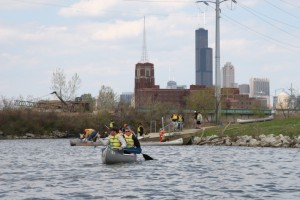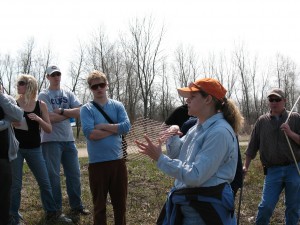This coming fall semester, SUST 220 Water will be offered for the first time at RU’s Schaumburg Campus. The 12-week course will run in a unique “hybrid” format combining four Saturday meetings (from 10am to 4pm) with online interaction via the course Blackboard site during the intervening weeks. This weekend/hybrid schedule not only makes the course accessible to students in the suburbs as well as the city, it provides us with the opportunity to pursue some interesting water-focused field trips to instructive sites in the region, such as the Chicago River (which just received this good news about its future water quality) and the Des Plaines River Wetland Demonstration Project (just to mention a couple of places I have taken past classes).

Course Profile / Registration Info
- SUST 220 Water, section L30 (Schaumburg Campus) / Fall 2011
- Meeting dates: Sept 10th, Oct 8th, Oct 29th, and Dec 3rd
- Pre-req: English 101
- Online interaction required through RU Online / Blackboard
- Taught by: Professor Mike Bryson (mbryson@roosevelt.edu / 847.619.8735)
These books are on order at the RU bookstore:
- Shimon C. Anisfeld, Water Resources (Island Press, 2010, paper, ISBN 1597264954)
- Peter Annin, The Great Lakes Water Wars (Island Press, 2009, paper, ISBN 9781597266376)
Recommended but not required is an excellent text I used last year in the augural section of SUST 220 — The Atlas of Water, by Maggie Black and Jannet King (Univ of CA Press, 2nd ed., 2009).
If you are interested in enrolling in SUST 220 this coming fall, please contact your academic advisor, and feel free to get in touch with me if you want to learn more about the course. Enrollment is limited, so plenty of personal attention from yours truly is guaranteed. And if you’ve never tried an online course before, taking a hybrid course such as this is a great way to “test the waters,” since students will have ample opportunity to interact with me and each other face-to-face, as well as get help/support with the online component if need be.

Like to know more? Below is a preview of the kinds of topics we’ll investigate in SUST 220.
Water, the Stuff of Life
Without water there is no life. Without clean water, human and animal life is vulnerable to catastrophic disease. How, despite population growth and industrial production, can we ensure clean supplies of water for humans and wildlife? This course evaluates water quality and water sustainability issues through the analysis of local, regional, and global issues and case studies.
Consider, for example, the connections between local and regional water issues here in the Chicago area. Chicagoans have the luxury of living on the shores of the world’s greatest repository of fresh surface water, the Great Lakes, a position we regrettably abuse by withdrawing several hundred million gallons of Lake Michigan water every day simply to flush our sewage downstream to Peoria and all points south. By contrast, most communities in northeastern Illinois that lie outside the Great Lakes basin draw their water from surface streams or underground aquifers, sources that are vulnerable to over-use and pollution. According to the 2009 report “Before the Wells Run Dry” by the Chicago-based Metropolitan Planning Council and Openlands, the long-term sustainability of fresh water in Illinois requires much better conservation of these finite resources and improved long-term water supply planning.
: : For more information on local water issues, as well as sustainability events and issues within the Chicago region, be sure to check out the Sustainability Studies @ Roosevelt University Blog, which just reported on a landmark vote on June 7, 2011, by the Metropolitan Water Reclamation District to start disinfecting wastewater returned to the Chicago River.

A global perspective on water availability reveals far more disturbing realities. The earth is a planet defined by an abundance of water, of which almost 98 percent is salty or brackish. Just over two percent is fresh, and more than two-thirds of that water is locked up in ice sheets, glaciers, and permafrost. Thus, only a tiny fraction of the earth’s water is available to us for drinking, bathing, flushing toilets, growing crops, etc. That finite resource is imperiled by the unsustainable trends of pollution, overuse, waste, and lack of access. In developing countries, about 90 percent of sewage is dumped into rivers without any treatment. Worldwide, polluted rivers transport toxins and excess nutrients to coastal areas, where biological “dead zones” result; from 1995 to 2007, the number of such oceanic dead zones increased by 30 percent. Depending where you look, overconsumption or scarcity is the defining problem. Citizens of the US accustomed to readily available freshwater consume about 100 gallons day per household, on average; while globally, nearly two billion people lack ready access to clean water.
Key concepts and themes addressed in SUST 220 include the science and policy of ensuring a safe water supply; water conservation strategies, particularly in urban areas; wastewater treatment and watershed management; and wetlands ecology, restoration, and management. Students will develop a thorough understanding of the water cycle and its relation to the sustainability of water systems; understand and assess the importance of water as an environmental as well as cultural resource; learn to define, measure, and sample water quality in a variety of contexts using simple yet effective field-based water chemistry sampling techniques; and evaluate contemporary water management and policy issues, particularly those affecting the waterways of the Chicago region as well as the Great Lakes ecosystem.
8 thoughts on “SUST 220 Water — Fall Preview”
Comments are closed.